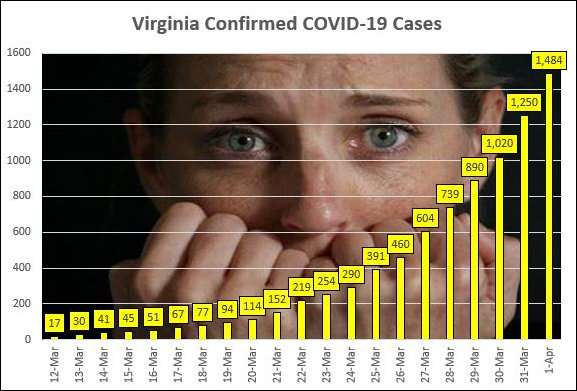
The Virginia Department of Health has updated its statistics to reflect yesterday’s numbers. The big movers: hospitalizations and deaths, both of which surged 26%.
Total confirmed COVID-19 cases: 1,484, up 234
Total hospitalizations: 208, up 43
Total deaths: 34, up 7
Total tests: 15,344, up 1,943
Here are John Butcher’s latest calculations for the “doubling” rate for key metrics:
Confirmed cases: 3.2 days
Hospitalizations: 3.7 days
Deaths; 2.9 days
The hopeful news is that the doubling rate for hospitalizations shows signs of stretching out. It makes a substantial difference if it takes 3.7 days for hospitalizations to double compared to 3.0 days. A top public health challenge is to “flatten the curve” — to prevent Virginia hospitals from getting overwhelmed with COVID-19 patients at one time.
I question, however, how well the VDH data reflects the reality in hospital wards and emergency rooms. Bon Secours Mercy Health, which operates 11 hospitals in the Richmond and Hampton Roads regions, announced yesterday that it has furloughed 700 full-time employees across seven states and 12 markets, reports Virginia Business.
The furloughs come as a result of fewer people seeking primary care, outpatient and surgical services. Most health car services being performed are related to COVID-19. Stated the press release:
In response to this unprecedented situation … our ministry is acting quickly to redeploy or temporarily furlough associates who are unable to work due to temporary closure, cancellation and low census in primary care, outpatient and surgical services. This will also affect many support services associates who are not directly working on COVID-19 activities. We are also suspending hiring for any positions not directly impacting our COVID-19 and care responses. …
The efforts of our entire team, combined with the tough decisions we are making today, will enable us to continue to focus on the COVID-19 response, which we expect to escalate in the coming weeks.
It is not known how many of the furloughs reflect medical conditions Bon Secours is facing here in Virginia. The nonprofit Catholic hospital chain has facilities located in Florida, Maryland, Michigan, Pennsylvania, South Carolina and Virginia. But this is powerful anecdotal evidence that the coronavirus may be stressing Virginia’s hospitals far more than would be indicated by the officials “hospitalization” number of 43.
— JAB

Leave a Reply
You must be logged in to post a comment.